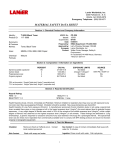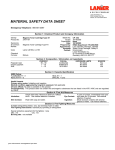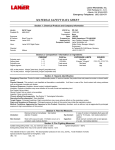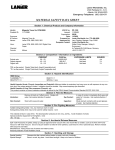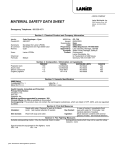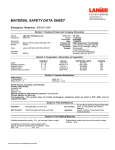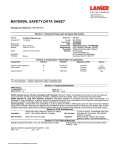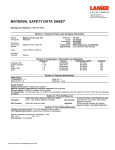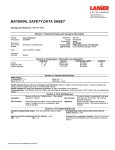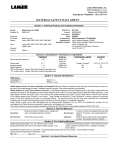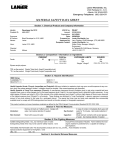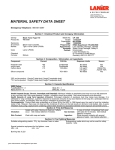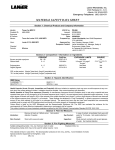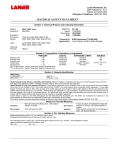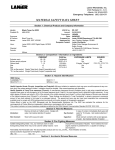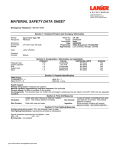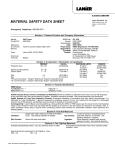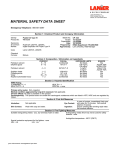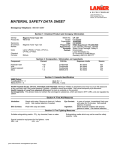Download Lanier 5485 User's Manual
Transcript
Lanier Worldwide, Inc. 2300 Parklake Dr., N. E. Atlanta, GA 30345-2979 Emergency Telephone: (800) 526-4371 MATERIAL SAFETY DATA SHEET Section 1: Chemical Product and Company Information Identity: Product ID: 5485 Toner 480-0034 Synonyms & Common Names: Toner for Lanier 5485 Uses: Lanier 5485 Chemical Formula: Mixture MSDS No. Issued: Supersedes: Date: Prepared by: Approved by: European Contact: CP- 339 04/20/2000 None 04/20/2000 EH&S Department 770-496-9500 Larry Choskey, Manager, CEH&S Walter Fricke, Manager, Safety & Environment, Lanier Worldwide, Inc. Im Taubental D-41468 Neuss, Germany +49-2131-387-177 Section 2: Composition / Information on Ingredients PERCENT CAS No. EXPOSURE LIMITS Polyester resin 60 – 80 Styrene acrylic polymer 10 – 30 Carbon black 7 – 15 Wax <5 Dye <1 *PEL as the product: 15mg/m3 (total dust), 5mg/m3 (respirable dust) *TLV as the product: 10mg/m3 (total dust), 5mg/m3 (respirable dust) Confidential 25767-47-9 1333-86-4 8015-86-9 31714-55-3 8mg/m3 Not listed 3.5mg/m3 3.5mg/m3 Not listed Not listed SOURCE ACGIH TWA N/a OSHA PEL ACGIH TWA N/a N/a Section 3: Hazards Identification HMIS Rating: FLAMMABILITY = 1 REACTIVITY = 0 HEALTH = 1 SPECIAL = none Health Hazards (Acute, Chronic, Immediate and Potential): Minimum irritation to respiratory tract may occur as with exposure to any nontoxic dust. May cause gasping if inhaled. Inhalation should be avoided. May cause temporary eye discomfort. Health Hazards of Long Term exposure (Chronic): A manufacturer sponsored chronic inhalation study in rats using a special test toner revealed there were no lung changes at all in the lowest exposure level (1mg/m3), the most relevant level to potential human exposures. A very slight degree of fibrosis was noted in 25% of the animals at the middle exposure level (4mg/m3), while a slight degree of fibrosis was observed at the highest exposure level (16mg/m3) in all animals. These findings are attributed to “Lung Overloading”, a generic response to excessive amount of any dust retained in the lungs for a prolonged interval. The special test toner was ten times more respirable than commercially available toner to comply with EPA testing protocol and would not function properly in Xerographic equipment. Carbon Black is listed on the IARC Monograph and the Massachusetts Substance List. The IARC has evaluated the evidence for the carcinogenicity of Carbon Black as inadequate to determine a carcinogenic risk for humans. This product contains no known hazardous materials as defined by the OSHA Hazard Communication Standard 29 CFR 1910.1200. Section 4: First Aid Measures Inhalation: Remove to fresh air if effects occur. Get medical attention if needed. Eye Contact: Skin Contact: Wash with soap and water. Ingestion: In case of contact, immediately flush eyes with water for 15 minutes. Get medical attention if needed. Dilute stomach contents with several glasses of water. Get medical attention. Section 5: Fire Fighting Measures Suitable extinguishing media: CO2, dry chemical, foam or water. Extinguishing media which may not be used for safety reasons: none This material will burn in case of fire. The decomposition products are CO, CO2, and No x. Avoid inhalation of smoke. Special protective equipment for fire fighters: none UEL: n/a LEL: n/a MATERIAL SAFETY DATA SHEET Page 2 of CP-339 Section 6: Accidental Release Measures Spill / leak Procedures: If spilled, sweep up using an approved toner vacuum with a 0.5 micron filter or smaller, such as the Atrix AAA Toner Vacuum or 3M Toner Vacuum. Use of a vacuum cleaner not rated for toner particles, could result in a fire or personal injury. Remove residue with soap and cold water. Miscellaneous: Keep product out of sewers and watercourses. Personal protection: Avoid inhalation of dust. Section 7: Handling and Storage Special Handling: Special Storage: Cleanse skin after contact before breaks or meals, and end of workday. Avoid direct sunlight. Keep out of reach of children. Store in a cool, dry place. Section 8: Exposure Control and Personal Protection Information: Respiratory Protection: none required under normal use. Hand Protection: none required under normal use. Eye Protection: none required under normal use. Skin Protection: none required under normal use. Section 9: Physical and Chemical Properties CHARACTERISTICS: Appearance: Form: Odor: Solubility in Water: Specific gravity: Bulk Density: Black Powder Slight plastic odor Insoluble N/a 1.2 g/cm3 Melting point: Vapor pressure: Vapor density: Evaporation rate: Boiling point: n/a n/a n/a n/a n/a Section 10: Stability and Reactivity Conditions to avoid: none Materials to avoid: none Stability: Stable Hazardous decomposition products: CO and CO2 and other decomposition products when burned. Section 11: Toxicological Information: Ames test negative Acute oral toxicity: >5000mg/kg (rat) Section 12: Environmental / Ecological Information Acute toxicity to fish: >500 mg/kg/96hr. Section 13: Disposal Consideration Used Toner should be disposed of under conditions that meet all federal, state and local environmental regulations. Disposal regulations vary from locality to locality, therefore consult your local Lanier office or the EPA to determine the proper method for disposal. Do not incinerate loose or spilled Toner. Section 14: Transportation Information None. This is not a hazardous product. Section 15: Regulatory Information WHMIS Legislation (Canada): This is not a controlled product UN No.: None allocated Section 16: Miscellaneous Information Judgment as to the suitability of information contained herein for user’s purposes is the responsibility of the purchaser. Therefore, although reasonable care has been taken in the preparation of this information, Lanier Worldwide, Inc. extends no warranties, makes no representations, and assumes no responsibility as to the accuracy or suitability of such information for application to user’s intended purposes or for Information on this data sheet represents our current data and best opinion as to the proper use in handling of this product under normal conditions. On the basis of the data available to us, this product is not a dangerous substance. One should, however, observe the usual precautionary measures for dealing with chemicals. MATERIAL SAFETY DATA SHEET Page 3 of CP-339 consequences of its use. All materials may present unknown hazards and should be used with caution. Although certain hazards are described herein, we do not guarantee that these are the only hazards that exist. Information on this data sheet represents our current data and best opinion as to the proper use in handling of this product under normal conditions. On the basis of the data available to us, this product is not a dangerous substance. One should, however, observe the usual precautionary measures for dealing with chemicals.




